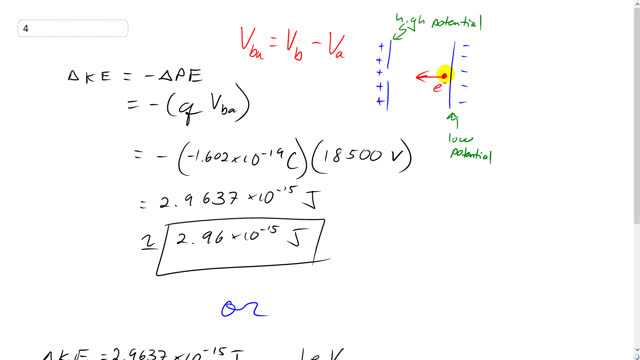
How much kinetic energy will an electron gain (in joules and eV) if it accelerates through a potential difference of 18,500 V?

In order to watch this solution you need to have a subscription.
This is Giancoli Answers with Mr. Dychko. When this electron accelerates due to the electric field it's going to go from a position of low potential to a position of high potential. Because electron is going to accelerate in the direction opposite to the direction of electric field. Electric field is pointing this way from positive to negative. So this idea of potential energy and electrons is a bit confusing because the electron actually has higher potential energy at its initial position than it does at the final position. And that's why it spontaneously accelerates from high potential energy position to a low potential energy position. And yet this final position is called the higher potential position because this word high potential or low potential are always with respect to a positive charge. So a positive charge would have high potential over here. Anyway I hope I'm not making it too confusing you can just straightforward plug into formulas and you'll get the right answer. But it is useful to have an understanding of why we're putting in positive 18500 volts here which is you know final potential minus initial potential when in fact the final is at a lower potential energy than the initial position. Because it's where potential is defined in terms of a positive charge and so it does end up at a position of higher potential. Even though it loses potential energy anyway so we put in 18500 volts here for the potential difference between these two plates and multiply by the charge q negative 1.602 times ten to the minus 19 coulombs charge on electron and the change in kinetic energy is gonna be the opposite to the change in potential energy. So whatever it loses in potential energy it will gain in kinetic energy. And sure enough this negative and this negative go together to show that it's this part here shows that it loses potential energy and then this negative here says that the change in kinetic will be the opposite to the change in potential. And so the change in kinetic is positive 2.96 times ten to the minus 15 joules it's going to gain that much kinetic energy at the expense of losing some potential energy. This is also 18500 electron volts when you multiply that answer by one electron volt for every 1.602 times ten to the minus 19 Joules.